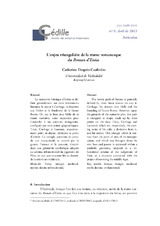L’enjeu triangulaire de la trame romanesque du Roman d’Enéas
Autor
Desprès Caubrière, Catherine
Editor
UCOPressFecha
2013Materia
EnéasTriangle
Médiéval
Mythe
Destin
Trifonctionnel
Aeneas
Triangle
Medieval
Myth
Destiny
METS:
Mostrar el registro METSPREMIS:
Mostrar el registro PREMISMetadatos
Mostrar el registro completo del ítemResumen
La trajectoire héroïque d’Enéas se définit généralement sur trois événements linéaires: le séjour à Carthage, la descente aux Enfers et la fondation de la future Rome. Or, sur la base plus fidèle de la trame narrative, cette trajectoire peut s’assimiler à un parcours triangulaire, configuré par trois points géographiques: Troie, Carthage et Laurente, respectivement point de départ, déviation et point d’arrivée. Ce triangle, pertinent du point de vue interprétatif, et motivé par la guerre, l’amour et le pouvoir, s’inscrit dans une géométrie symbolique adaptée au schéma trifonctionnel du jugement de Pâris, en tant que structure liée au dessein de la réécriture médiévale. The heroic path of Aeneas is generally defined by three linear events: his stay in Carthage, his descent into Hell, and the founding of future Rome. However, upon the grounds of the narrative plot, this path is triangular in shape, made up by three points on the map (Troy, Carthage and Laurente) which are, respectively, the starting point of his exile, a deviation from it, and his arrival. This triangle, which is relevant from the point of view of the interpretation, and which was brought about by war, love and power, is expressed within a symbolic geometry, adapted to a trifunctional scheme of the judgement of Paris, as a structure connected with the project of rewriting the middle Ages.

